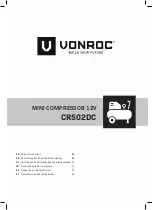
7
4.4
REFRIGERANT SAFETY DATA SHEET
Name:
R410A (50% Difluoromethane (R32); 50% Pentafluoroethane (R125).
RISKS INDICATIONS
Major risks:
Asphyxia
Specific risks:
The rapid evaporation may cause freezing.
FIRST AID
General information:
Never give anything by mouth to an unconscious person.
Inhalation:
Move to fresh air.
Oxygen or artificial respiration if necessary.
Do not administer adrenaline or similar drugs.
Eyes contact:
Rinse carefully with water for at least 15 minutes and consult a doctor.
Contact with skin:
Wash immediately with plenty of water.
Take off immediately the contaminated clothing.
FIRE PREVENTION
Extinguishing Media:
Whatever.
Specific risks:
Increase in pressure.
Specific methods:
Use water spray to cool containers
ACCIDENTAL RELEASE ACTIONS
Personal precautions:
Evacuate personnel to safe areas.
Provide adequate ventilation.
Use personal protective equipment.
Environmental
Evaporate.
Cleaning method:
Evaporate.
HANDLING AND STORAGE
Manipulation
Action/technical
Provide sufficient air exchange and/or suction in work places.
Recommendations for safe
Do not breathe vapors or aerosol.
Storage:
Close tightly and store in a cool, dry and well ventilated place.
Store in original container. Incompatible products: explosive, flammable materials, Organic
peroxide.
EXPOSURE CONTROL / PERSONAL PROTECTION
Control parameters:
AEL (8-h e 12-h TWA) = 1000 ml/m³ for each of the two components.
Respiratory protection:
For rescue and maintenance operation in storage tanks use self-contained respirator
The vapors are heavier than air and can cause suffocation by reducing oxygen available for
breathing.
Eyes protection:
Safety glasses.
Protection of hands:
Rubber gloves.
Hygiene measures:
Do not smoke.
PHYSICAL AND CHEMICAL PROPERTIES
Color:
Colorless
Odor:
Light.
Boiling point:
-52.8°C at atmospheric pressure.
Lighting point:
It does not ignite.
Density:
1.08 kg/l at 25°C.
Solubility in water:
Negligible.
STABILITY AND REACTIVITY
Stability:
No reactivity when used with the appropriate instructions.
Materials to avoid:
Highly oxidizing materials. Incompatible with magnesium, zinc, sodium, potassium and
The incompatibility is more serious if the metal is present in powdered form or if the surfaces
were, recently, unprotected.
Decomposition products
These products are halogenated compounds, hydrogen fluoride, carbon oxides (CO, CO
2
),
Risks:
TOXICOLOGICAL INFORMATION
Acute toxicity:
(R32) LC50/ inhalation /4 hours/on rat >760 ml/l
(R125) LC50/ inhalation /4 hours/on rat >3480 mg/l
Local effects:
Concentrations substantially above the TLV may cause narcotic effects.
Inhalation of decomposed products of high concentrations may cause respiratory failure
(pulmonary edema).
Long term toxicity:
Did not show any carcinogenic potential, teratogenic or mutagenic effects in animal experiments.
ECOLOGICAL INFORMATION
Global Warming Potential 2088
GWP (R744=1):
Ozone Depletion Potential 0
ODP (R11=1):
Disposal considerations:
Usable with reconditioning.








































